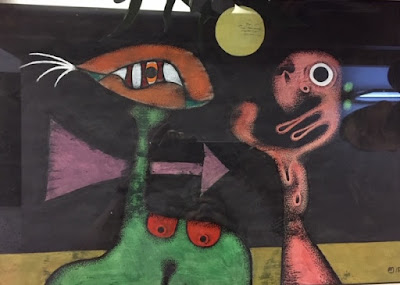We were very fortunate in having James Davies giving us a virtual talk in December, beginning with his early interest in photography, and talking about some of the projects he has been involved in over the years. The actual title of the talk was: 'The Photographer, the light, the building and getting it', I did take some photographs of the computer screen during the talk, including some fascinating ones taken inside Silbury Hill in 2007, inside prisons, power stations and at Stonehenge. I don't think I should use these photographs, but will include some James sent me to advertise his talk to give you an idea of what he means by photographs:
Above is Tokyo Cathedral designed by Kenzo Tange
This is a photograph of the 12th Century archway round a door at St Andrew's church at Great Rollright
Above might be a photograph inside Le Corbusier's
Villa SavoyeAbove is a photograph of an Angel sculpture from Whitehall Palace in 1686 now at Burnham on Sea in St. Andrew's church and below the font is from a church in Roche, Cornwall
Above
Landfall, Poole regarded as one of the finest Modern Movement buildings by one of the finest architects of the inter-war period, and below
Malator at Druidstone, Pembrokeshire built in the earth house architectural style.
I'll continue with some information I found by looking up James Davies, and adding the 'O'
'JAMES O. DAVIES has been an architectural photographer for
English Heritage for twenty three years. He has contributed to many
books in that time and his work has been widely exhibited and published
throughout the world. He is also a portrait photographer, twice
exhibiting in the National Portrait Gallery and having received various
awards, including Nikon Independent Award, Ilford Award, and Jane Bown
Portrait Award. He has taken the official Portrait of Her Majesty The
Queen Mother, as well as the first ever photographic survey of English
Prisons, published in two books. He is currently working on a book about
post war buildings in Britain.'
I then found information about James's book on Stonehenge which I have now bought:
'More than 4000 years old, the
true meaning of this ancient, awe-inspiring creation and the secrets of
its construction have been lost in the mists of time. Surrounded by
mystery, Stonehenge never fails to impress.
Over the last five
years James Davies has been photographing Stonehenge at all times of the
day and night, and all through the seasons. With privileged access to
the stone circle he has built up a unique portfolio. A Year at Stonehenge brings together the best of his work, while a short expert text summarises our current understanding.
Published
to coincide with the opening of a new environmentally sensitive visitor
centre and the restoration of the surrounding ceremonial landscape,
this is the most visually stunning book available on this most
fascinating world heritage site.'
I took notes throughout the fabulously illustrated talk, which I'll include here in an abbreviated form. Keeping verticals true is important, as is waiting for the light to be just right, although it might take all day, with ambient light being particularly important in churches and cathedrals to give the right atmosphere. Moving clutter from the scene you are about to photograph, particularly bags, and making sure the scene is as you want it before photographing it is important. James talked about what makes a great photograph, and showed us examples where he thought he could have done things differently to improve the photograph. James is currently recording the last coal and oil powered power stations, and had some fascinating shots inside them.
I've got a final note about getting low when taking photographs, and luck = readiness + opportunity there's also a mention of Tom Denny who made a fabulous tryptych at The Chapel of St.Thomas, Gloucester, do click on this link to see them, they were photographed by James O. Davies.
I also found a list of things to remember when taking photographs of buildings, please click on this link below for a more informative list than mine. A final thank you to James, and a recommendation to follow his Twitter feed @JamesODavies where we find out how James spent New Year's Eve and the photograph he took by moonlight.










